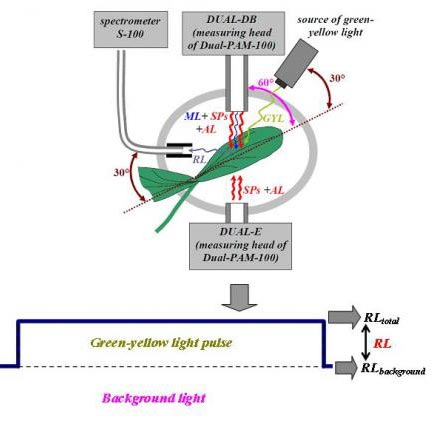
New Method Boosts Precision Farming with Photochemical Reflectance

Fig. 1. The general scheme of the experiment and the scheme of illumination of the plant by pulses of yellow-green light in the study. RL is the reflected light that was used to calculate the photochemical reflection index; RLtotal and RLbackground -- reflected light against the background of a pulse of yellow-green light without it.
Credit: Lobachevsky University
Precision farming, which relies on spatially heterogeneous application of fertilizers, biologically active compounds, pesticides, etc., is one of the leading trends in modern agricultural science.
A necessary condition for such farming is a quick and remote analysis of the state of plants in the fields and greenhouses. To solve this problem, various spectral indices based on measurements of reflected light in narrow spectral bands are widely used.
One of these indices, currently in the focus of attention of Lobachevsky University researchers, is the photochemical reflectance index – PRI.
The photochemical reflectance index is determined by measuring reflected light at two wavelengths in the yellow-green spectral range, at 531 and 570 nm, which is carried out using special detectors or multispectral cameras.
“A unique feature of the photochemical reflectance index is its sensitivity even to weak stress-related changes in the state of the photosynthetic apparatus. This opens up the potential possibility of using the photochemical reflectance index for early and remote diagnosis of how adverse factors may affect plants. However, the use of PRI has a number of serious limitations, one of them being the high sensitivity of the index to the lighting conditions, which is especially important if the measurements take place under solar lighting conditions,” says Vladimir Sukhov, head of the UNN plant electrophysiology laboratory.
This problem is addressed in the research project carried out by Ekaterina Sukhova, graduate student at the Department of Biophysics Lobachevsky University. The project was supported by the Russian Science Foundation (project No. 17-76-20032, supervisor Vladimir Sukhov). Research results were published in one of the leading scientific journals in the field of remote monitoring – Remote Sensing, 2019, 11 (7): 810.
For this purpose, Lobachevsky University scientists proposed an idea that could potentially reduce the sensitivity of the photochemical reflectance index to lighting conditions. It is based on the use of periodic illumination of the plant by pulses of yellow-green measuring light from a source with known spectral characteristics.
The intensity of the reflected light is calculated as the difference between the reflected light during each pulse of yellow-green light and before such a pulse (Fig. 1), which allows one to eliminate the influence of other light sources on the measurement results. Ekaterina Sukhova's research has proved that the use of yellow-green light pulses eliminates the distorting effects of other light sources on the measurement of the photochemical reflectance index, and therefore improves the accuracy of determining the PRI.
Further, the photochemical reflectance index was determined under conditions of stress-inducing light intensities in a number of agricultural plants and was compared with the generally accepted indicator of photosynthetic stress — non-photochemical quenching of chlorophyll fluorescence (Fig. 2).
“It appears that both indicators are closely related, which is confirmed by the use of the photochemical reflection index that was measured using yellow-green light pulses to assess the severity of photosynthetic stress of agricultural plants. The magnitude of the change in the photochemical reflectance index, which is linearly related to the intensity of stress on the plants under study, is a particularly effective indicator,” Ekaterina Sukhova comments.
On the whole, Lobachevsky University researchers obtained two significant results. First, it was shown that the use of periodic pulses of yellow-green light reduces the error in measuring the photochemical reflectance index and, secondly, scientists have found that the change of the PRI in the light is a more reliable indicator of the severity of photosynthetic stress in a plant than its absolute magnitude.
“These results provide the basis for a new approach to measuring the photochemical reflectance index, which involves pulsed illumination of the plant objects under study. The implementation of this approach opens up new prospects in remote monitoring of the state of agricultural plants. It means that this method will become an important tool in precision farming,” continues Ekaterina Sukhova.
Currently, scientists at Lobachevsky University and their colleagues from the Institute of Applied Physics of the Russian Academy of Sciences are working to further develop the proposed method and to adapt it for measuring the spatial distribution of the photochemical reflectance index.
“In particular, a PRI imaging system based on the illumination of objects under study with pulses of yellow-green light has already been developed and is being tested. It is expected that the prototype already developed will become the basis for a commercial system for assessing the state of plants based on measuring the spatial distribution of the photochemical reflectance index,” Ekaterina Sukhova concludes.












